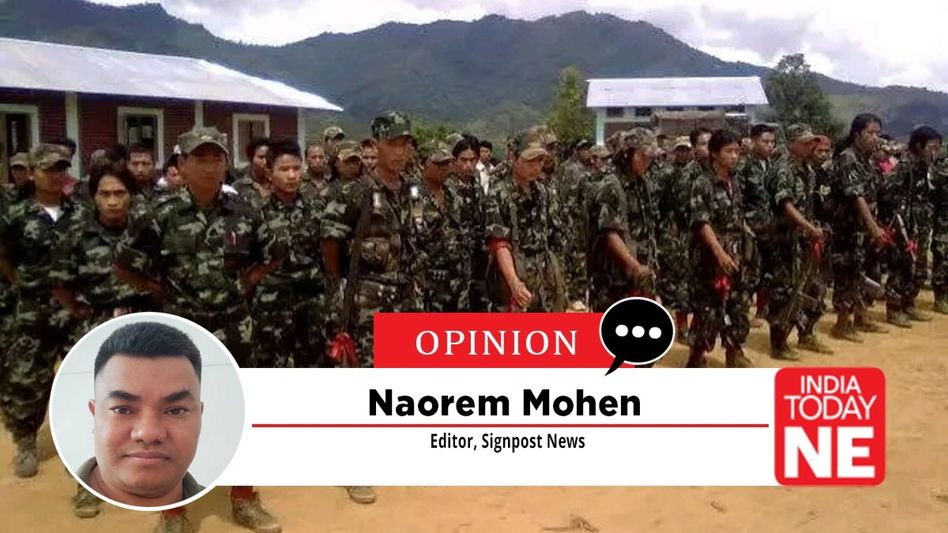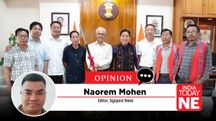Is the MHA Hiding a Plan to Split Manipur?
The Ministry of Home Affairs owes Manipur one unvarnished answer: is it standing by Union Home Minister Amit Shah’s repeated parliamentary pledge that the state will never be divided, or is it quietly engineering a separate political arrangement for the Kuki-Zo hills through back-room talks with the very armed groups that signed a pact promising the opposite just two months ago?

The Ministry of Home Affairs owes Manipur one unvarnished answer: is it standing by Union Home Minister Amit Shah’s repeated parliamentary pledge that the state will never be divided, or is it quietly engineering a separate political arrangement for the Kuki-Zo hills through back-room talks with the very armed groups that signed a pact promising the opposite just two months ago?
The people of Manipur—Meitei in the valley, Kuki in the hills, Naga on the fringes—have seen promises made in Parliament, agreements inked in New Delhi, highways opened and then shuttered again, camps relocated on paper but not on the ground, and now, in the first week of November 2025, they have watched MHA Advisor A.K. Mishra sit for two full days in the ministry’s North Block office listening to the Kuki National Organisation (KNO) and United People’s Front (UPF) demand nothing less than a Union Territory with its own Legislative Assembly.
AK Mishra’s response was not a flat refusal; it was a sympathetic murmur about “current policy” and a call for “consultations with other communities.” That is not the language of a government defending territorial integrity; it is the language of a government keeping every option on the table.
And the silence that has followed—especially Mishra’s refusal to issue a single public clarification—has only deepened the suspicion that the Centre is running two scripts: one for the Lok Sabha gallery, another for the closed conference rooms of the capital.
Let us rewind to the moment the ink was still wet on the document that was supposed to close the door on separatism. On 4 September 2025, in a tripartite ceremony in New Delhi, the Ministry of Home Affairs, the Government of Manipur, and the umbrella leadership of the KNO and UPF put their signatures to a freshly re-negotiated Suspension of Operations agreement.
The text could not have been plainer. It spoke of “re-negotiated terms and conditions or ground rules” and, in the same breath, “reiterated the territorial integrity of Manipur.” It was not a side clause; it was the centrepiece.
AK Mishra must clarify outcomes of the Nov 6-7 talks with regards to the SoO clause: "The SoO Agreement shall be followed by tripartite dialogue with KNO and UPF to pave the way for a negotiated political settlement under the Constitution of India in a time bound manner." What is that Political solution MHA will gift to the SoO Groups?
The pact also committed the SoO groups to relocate seven designated camps from conflict-prone areas, reduce the overall number of camps, deposit every weapon in double-locked CRPF or BSF storerooms, and submit to stringent physical verification of cadres to weed out foreign nationals. A Joint Monitoring Group was constituted to police compliance, with the MHA reserving the right to review or even scrap the entire agreement if violations occurred.
Manipur Chief Secretary Puneet Kumar Goel stepped before the press the very next day, 5 September, and declared that “agreements signed with Kuki-Zo groups will be honoured” while the state government worked round the clock to restore normalcy.
The same day, the Kuki-Zo Council—acting in parallel—announced that National Highway-2, the arterial road linking Imphal to Dimapur and the rest of India, would be reopened for unrestricted movement of commuters and essential goods, with the council pledging full cooperation with central security forces to keep the peace.
For a brief moment, it looked as if the Centre had finally drawn a line in the red soil of Manipur: no more fragmentation, only integration.That moment lasted exactly eleven days.
On 15 September the Kuki-Zo Council rescinded its highway commitment, declaring that NH-2 would remain blocked. No apology, no explanation to the Joint Monitoring Group, no consultation with the state government.
The MHA’s response? Silence. No public reprimand, no activation of the violation clause, no demand that the KNO and UPF honour the tripartite pact they had signed. Instead, six weeks later, on 6 and 7 November, the same KNO and UPF delegations were flown back to Delhi, put up in government guest houses, and ushered into the MHA’s conference room for a marathon dialogue whose stated centrepiece was the creation of a Union Territory with a Legislative Assembly.
Day one, according to the ministry’s own briefing, was supposed to focus on “implementation” of the September agreement—governance in Kuki-Zo districts, administrative bottlenecks, the plight of internally displaced persons.
Day two veered straight into high politics. The KNO/UPF leadership told Mishra that “coexistence under the Manipur state administrative setup is no longer possible” because of what they called the “ethnic cleansing” that began in Imphal on 3 May 2023. They invoked the Constitution, insisting it stood above government policy and could be stretched to accommodate a new UT to “secure Kuki-Zo lives and property.”
AK Mishra, the man who had co-signed the September pact on behalf of the MHA, did not interrupt to remind them that the same Constitution had just been cited to reaffirm Manipur’s territorial integrity. He did not point out that the September agreement explicitly ruled out separate political solutions.
Instead, he listened, expressed “sensitivity,” repeated that “current policy does not support creation of new Union Territories,” and then—crucially—added that the matter required “consultations with other communities in Manipur.” That single sentence turned a red line into a dotted line.
It signalled that the door was not closed; it was merely ajar.The question that now hangs over North Block like monsoon mist is simple: who was representing the state of Manipur in that room?
The September pact was proudly tripartite—MHA, Government of Manipur, KNO/UPF. The November talks were billed as a continuation of the same process. Yet no minister, no bureaucrat, no elected representative from Imphal was visible at the table. The state government, which had been assured by its own Chief Secretary that every clause would be honoured, was reduced to a bystander while the Centre entertained demands that would amputate half its territory.
If the pact was tripartite, where was the third party? If the pact was no longer tripartite, why was the state not informed? And if the state was informed, why has Governor Ajay Kumar Bhalla not uttered a word of protest? The silence is deafening, and it is corrosive.
Equally corrosive is the MHA’s refusal to call out the SoO groups for their own public misrepresentation of the September agreement. Three days after the pact was signed, on 7 September, the KNO and UPF issued a joint statement accusing the Press Information Bureau of “spinning” the official text.
They quoted the actual clause: “SoO Agreement shall be followed by a tripartite dialogue with KNO and UPF to pave the way for a negotiated political settlement under the Constitution of India in a time-bound manner.”
They then contrasted it with the PIB’s summary: “Among other provisions, the revised ground rules reiterated: Need for a negotiated solution to bring peace and stability to the State of Manipur.” The difference, they claimed, was deliberate distortion designed to downplay their political aspirations and upset Kuki-Zo sentiment ahead of a proposed prime ministerial visit to Churachandpur.
Their statement went viral in the hills. The MHA’s response? Another round of silence. No rebuttal, no clarification, no demand that the SoO groups retract their accusation if they wished to remain credible partners in the tripartite framework.
A.K. Mishra, who had sat across the table from these same leaders on 4 September and watched them append their signatures to the very clause they later disowned, said nothing. He has still said nothing. Why has the ministry not asked—publicly, pointedly—how signatories to a solemn agreement can turn around seventy-two hours later and accuse the government of falsifying its contents?
Why has AK Mishra not issued a single press note correcting the record? The absence of outrage is itself an answer: the MHA is willing to tolerate public distortion if it keeps the dialogue channel open.That channel is now being used to float the most explosive demand in Manipur’s modern history.
A Union Territory with a Legislative Assembly is not a minor administrative tweak; it is a constitutional rupture. It would detach the hill districts—Churachandpur, Pherzawl, Chandel, Tengnoupal, Kangpokpi, and parts of Tamenglong and Ukhrul—from Imphal’s jurisdiction, create a new capital, a new legislature, a new budget, and a new security architecture answerable directly to New Delhi.
It would formalise the ethnic partition that armed groups on both sides have been enforcing with bullets since May 2023. It would reward the very violence the September pact was meant to extinguish.
And it would do so in direct contravention of Prime Minister Narendra Modi and Union Home Minister Amit Shah’s assurances to Parliament, to all-party delegations, and to the people of Manipur.
Yet the MHA’s own briefing on the November talks lists the UT demand as the “core” item on the agenda, alongside perfectly legitimate grievances—land rights, forest rights, succession of village chiefs, simplified land registration without having to travel to an Imphal now deemed unsafe, expedited rehabilitation of IDPs with security and amenities.
These are real issues; they deserve real solutions. But bundling them with a separatist demand and then refusing to reject that demand outright is not sensitivity; it is strategic ambiguity.The people of Manipur are not asking for ambiguity. They are asking for consistency.
They want to know why the MHA is in such a hurry to welcome the SoO groups back to the table when the ink on the September commitments is barely dry and the highway remains choked.
They want to know why camps that were supposed to be relocated by October are still squatting in “vulnerable areas,” why cadre lists have not been fully verified. They want to know why the Joint Monitoring Group has not issued a single public report on compliance.
And above all, they want A.K. Mishra to step before the cameras and answer three straightforward questions in public:
Who represented the Government of Manipur in the 6–7 November talks, and why was the state government not visibly present if the September pact was tripartite?
Why did the MHA not challenge—then or now—the KNO/UPF accusation that the PIB falsified the September agreement, an accusation that undermines the credibility of the entire tripartite process?
Is the territorial integrity of Manipur still non-negotiable, or is the Centre willing to entertain constitutional amendments to create a new UT in defiance of Amit Shah’s parliamentary assurances?
Until AK Mishra answers, every IDP shivering in a relief camp, every farmer unable to reach his fields because the valley and the hills no longer trust each other, will carry the same accusation: the Centre is playing a double game.
Publicly it swears by unity; privately it negotiates disunity. The longer the silence lasts, the louder that accusation becomes. Manipur has waited long enough. Give the state the facts. Let its people decide whether to accept a future dictated in closed rooms or to demand a government that keeps its word.
Copyright©2025 Living Media India Limited. For reprint rights: Syndications Today








